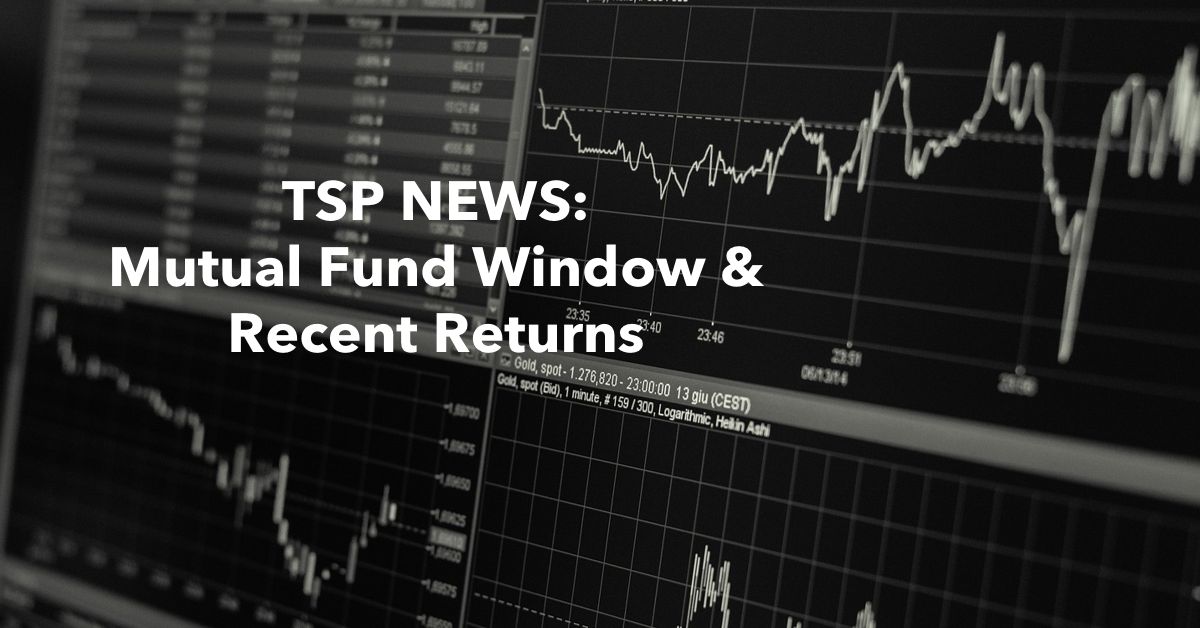Examining the underwhelming use of the TSP mutual fund window after opening in June 2022. Also checking in on the core funds’ recent performance.
Thrift Savings Plan News: Underwhelming MFW Use and Recent Fund Performance
The Thrift Savings Plan (TSP) is a vital retirement savings tool for federal employees, offering a range of investment options designed to help participants grow their retirement funds. When it comes to the specific investment options, there are the five “core” TSP funds (C, S, I, F, and G) along with different allocations of these funds available through “Lifecycle” funds that take into account a target retirement date for participants. These core funds track market indices (except for the G-Fund. Read more about the August 2024 G-Fund rate for more information.) The core funds are pretty standard investment choices: the C-fund for large-cap US stocks, the S-fund for small, mid, and large US companies, the I-fund for international investments, and then the F-fund for fixed income (bonds).
For more sophisticated or selective investment choices, the TSP offers the mutual fund window (MFW). If TSP account owners are eligible and choose to invest in the MFW, they have a plethora of mutual funds to choose from (roughly 5000 in fact). For example, some of these mutual funds may focus on a particular type of stock (value vs. growth) or only invest in ESG funds, international stocks from China, or US small cap stocks. (Read an Inside Look at the TSP Mutual Fund Window for more details.) However, since opening more than 2 years ago, fewer feds than anticipated have accessed the window.
This article reviews the lower-than-expected utilization of the TSP Mutual Fund Window, along with a recap of the main TSP funds’ recent performance. Then a brief overview will be provided of the workings, benefits, eligibility, investment options, risks, and management strategies of the TSP MFW.
Want a snapshot of your retirement benefits? Schedule a Meeting Today!
TSP Returns Remain Positive After July and August
For the most part, the main TSP funds have been experiencing a resilient year so far. All 5 have grown by at least 3% since January 1st with the C-fund at just under 17%. The second highest so far is the I-fund with over 10% year-to-date (YTD) and then the S-fund third with 6.84%. The G-fund saw consistent monthly returns from June to the end of August and is at 3.00% YTD as of September 3rd. The F-fund remained in positive territory through the summer months as well and has grown 3.63% YTD, as seen in the table below.
2024 Monthly and YTD Rates of Return for TSP Funds
| June | July | August | 2024 YTD* | |
| G-Fund | 0.38% | 0.39% | 0.35% | 3.00% |
| F-Fund | 0.94% | 2.33% | 1.43% | 3.63% |
| C-Fund | 3.58% | 1.21% | 2.42% | 16.98% |
| S-Fund | -0.10% | 6.23% | 0.25% | 6.84% |
| I-Fund | -1.62% | 2.86% | 3.15% | 10.22% |
data source: tspdatacenter.com *YTD as of 9/3/2024
Want to learn more about managing your TSP and planning for your retirement? Attend a free FERS webinar!
Mutual Fund Window Participation Lower than Expected
Participation in Window Well Below Anticipated Amounts
A recent TSP board meeting revealed that about 5,500 TSP investors were currently invested in the markets via the MFW, with $7.1 million invested in the numerous mutual funds. This may sound large without context but it is important to remember that there are roughly 7 million people that have money in a thrift savings plan account with a total of $927 billion invested. When the MFW was first opened, the FRTIB (Federal Retirement Thrift Investment Board) anticipated 1% to 3% of account owners would access it. The 5,500 individuals who actually did utilize the window is about 0.08% of participants and the $7.1 million is about 0.0008% of the total amount of money in the TSP (both well below 1%). It is also important to note that the 5,500 accounts which are invested in the MFW have a collective total TSP balance of over $400 million. So even those with the MFW opened are ultimately only investing about 1.7% of their retirement savings into the options available through the new window.
Fees and Other Barriers
There are many factors that are likely preventing federal employees from using the MFW at the expected capacity. One of the main reasons is fees. There is not only a one-time fee to open the window, but also each mutual fund charges an expense ratio and there’s an annual fee that is currently around $150, and then also a $28.75 charge for every trade executed, both to buy and sell, within the MFW. On top of that, there is a requirement that no more than a quarter of your TSP balance can be in the window. Along with a $10,000 minimum balance that needs to be transferred into the MFW before it can be opened, this automatically prevents anyone with a TSP balance of less than $40,000 from attaining access. And lastly, as displayed above, the TSP core funds have been resilient lately and performing relatively well. If federal employees want to explore other investment strategies not available through the core thrift savings plan funds, there are likely less limiting and cheaper options out there—like a non-retirement brokerage account, an IRA, or even exploring whether you should transfer out of the Thrift Savings Plan.
Planning your retirement from the federal government? Try our Thrift Savings Plan Calculator
Knowledge is Confidence!
General Overview of the TSP’s Mutual Fund Window
Understanding the Basics of the TSP
The Thrift Savings Plan is a retirement savings and investment plan for federal employees and members of the uniformed services. It is similar to a 401(k) plan and offers various investment options, including the G Fund, F Fund, C Fund, S Fund, and I Fund. Each of these TSP funds has its unique characteristics, risk levels, and potential returns. The TSP is designed to help participants save for retirement through tax-deferred contributions, allowing their investments to grow over time without immediate tax implications.
How Can Federal Employees Use the Mutual Fund Window?
Steps to Access the Thrift Savings Plan MFW
Accessing the TSP Mutual Fund Window involves several straightforward steps. First, participants must log into their TSP account and navigate to the mutual fund window option. Once there, they can review the list of available mutual funds and select the ones they wish to invest in. After choosing the mutual funds, participants will need to complete the necessary online forms to open a mutual fund window account. This process may include providing information about the specific funds selected and acknowledging any associated fees. Once the account is established, participants can begin to trade and manage their investments within the MFW.
Common Mistakes to Avoid When Using the TSP
While the TSP Mutual Fund Window offers numerous benefits, there are common pitfalls that investors should be aware of. One significant mistake is failing to thoroughly research the available mutual funds before making investment decisions. Each fund has its own risk profile, fees, and performance history, and neglecting to consider these factors can lead to suboptimal investment choices. Additionally, investors should be cautious about overtrading within the mutual fund window, as frequent trades can incur additional fees and negatively impact overall returns. Lastly, it is essential to regularly monitor the performance of mutual funds and rebalance the portfolio as needed to align with changing market conditions and personal financial goals. (Learn more in our guide on avoiding TSP misconceptions.)
What Investment Options Are Available in the TSP Mutual Fund Window?
Types of Mutual Funds Offered
The TSP Mutual Fund Window provides access to a diverse array of mutual funds, including equity funds, bond funds, and balanced funds. Equity funds primarily invest in stocks and can offer higher potential returns, albeit with increased risk. Bond funds, on the other hand, focus on fixed-income securities and tend to be less volatile, making them suitable for conservative investors. Balanced funds combine both stocks and bonds, providing a middle ground for those seeking a diversified investment approach. Participants can choose from various fund families, allowing them to tailor their investment strategies to their specific needs and preferences. (Check out our article on comparing mutual funds and ETFs for more insight.)
Investments in Mutual Funds Within the MFW: Volatility and Inflation
Understanding Market Risks and Volatility
Market risks and volatility are inherent in investing, particularly when it comes to mutual funds that include stocks. Economic downturns, changes in interest rates, and geopolitical events can all impact market performance and, consequently, the value of mutual funds. Investors should be prepared for fluctuations in their account balance and understand that short-term volatility does not necessarily reflect the long-term potential of their investments. It is crucial to maintain a long-term perspective and avoid making impulsive decisions based on temporary market conditions.
The Impact of Inflation on Your Investments
Inflation can significantly affect the purchasing power of retirement savings, making it essential for TSP participants to consider its impact on their investments. As inflation rises, the real returns on investments may diminish, potentially eroding the value of the account balance in the mutual fund window. To combat inflation, investors should seek mutual funds that have historically outpaced inflation rates, such as equity funds. Additionally, incorporating inflation-protected securities into the portfolio can provide a hedge against rising prices. By understanding the implications of inflation and adjusting investment strategies accordingly, participants can better safeguard their retirement savings.
Reach Out to Us!
If you have additional federal benefit questions, contact our team of CERTIFIED FINANCIAL PLANNER™ (CFP®), Chartered Federal Employee Benefits Consultants (ChFEBC℠), and AIF professionals. At PlanWell, we are federal employee financial advisors with a focus on retirement planning. Learn more about our process designed for the career fed.
Preparing for federal retirement? Check out our scheduled federal retirement workshops. Sign up for our no-cost federal retirement webinars here! Make sure to plan ahead and reserve your seat for our FERS webinar, held every three weeks. Want to have PlanWell host a federal retirement seminar for your agency? Reach out, and we’ll collaborate with HR to arrange an on-site FERS seminar.
Want to fast-track your federal retirement plan? Skip the FERS webinar and start a one-on-one conversation with a ChFEBC today. You can schedule a one-on-one meeting using our contact form.










